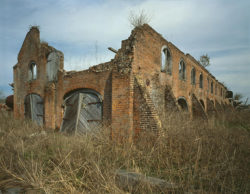Laurel Valley Plantation
In the early twentieth century, Thibodaux's Laurel Valley Plantation was the largest sugar producer in the region and employed as many as 450 workers.

Courtesy of Library of Congress Prints and Photographs Division.
A view of the ruins of a brick sugar mill on Laurel Valley Sugar Plantation in Thibodaux, Louisiana.
In 1832 Tennessee native Joseph W. Tucker established Laurel Valley sugar plantation along Bayou Lafourche in Thibodaux on land he purchased from Etienne Boudreaux, an Acadian exile who had settled there in 1790. Tucker brought twenty-two slaves with him from Tennessee. The house he built for his fifteen-year-old wife, Marceline Gaude, was burned at the Battle of Lafourche Crossing during the Civil War; the present structure dates from circa 1880.
Over the decades, the plantation increased in size, experiencing its greatest prosperity in the sugar-boom years between 1890 and 1924. During that period, fifteen miles of railroad track were built on the plantation to move cane from the fields to the mill. More than forty-three miles of canals and ditches drained excess water from the plantation, depositing it over a protective levee at the rear of the plantation into Bayou Lafourche. Today this 5,000-acre plantation retains approximately sixty buildings, now uninhabited, that date from the early twentieth century—when the plantation was the largest sugar producer in the region. At that time, Laurel Valley employed as many as 450 workers, mostly white Acadians, and more than 300 of them lived on the plantation. The tenant houses, arranged in neat rows, were constructed of cypress and raised on low brick piers. Although originally roofed with wood shingles, they now have metal roofs. Most cabins date from the late 1880s, although a few may date from the 1850s. Several houses retain a free-standing wood-frame privy at the rear.
Other structures include the ruins of a brick sugar mill (ca. 1845) and a small schoolhouse (ca. 1910) that was in use until 1952. All of these buildings line Laurel Valley Road, 1.7 miles off Louisiana 308. At the corner of Louisiana 308 and Laurel Valley Road is the plantation store (established 1905), which is also a small museum, along with a sharecropper’s two-bay house (ca. 1875). Laurel Valley has been the setting for several movies, including the slave-quarter scene in Interview with the Vampire (1994), which was based on New Orleans author Anne Rice’s novel, and the film of Ernest J. Gaines’s novel, A Lesson Before Dying (1999), in which the schoolhouse, with a cross added to its roof, featured as the church.
Adapted from Karen Kingsley’s Buildings of Louisiana, part of the Buildings of the United States series commissioned by the Society of Architectural Historians (www.sah.org) and published by Oxford University Press.
